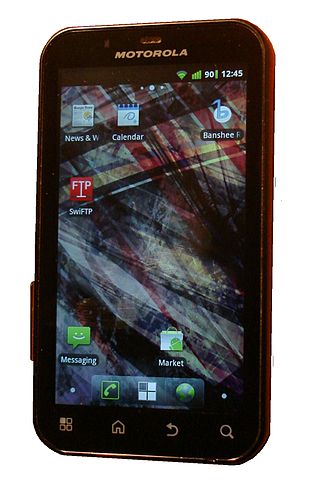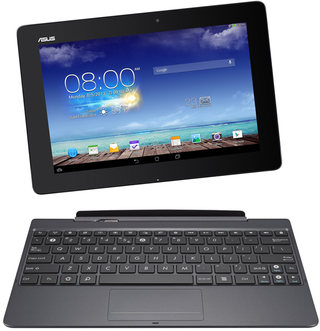Archos is a French multinational electronics company that was established in 1988 by Henri Crohas. Archos manufactures tablets, smartphones, portable media players and portable data storage devices. The name is an anagram of Crohas' last name. Also, in Greek (-αρχος), it's a suffix used in nouns indicating a person with power. The company's slogan has been updated from "Think Smaller" to "On The Go", and the current "Entertainment your way".

An ultra-mobile PC, or ultra-mobile personal computer (UMPC), is a miniature version of a pen computer, a class of laptop whose specifications were launched by Microsoft and Intel in Spring 2006. Sony had already made a first attempt in this direction in 2004 with its Vaio U series, which was only sold in Asia. UMPCs are generally smaller than subnotebooks, have a TFT display measuring (diagonally) about 12.7 to 17.8 centimetres, are operated like tablet PCs using a touchscreen or a stylus, and can also have a physical keyboard. There is no clear boundary between subnotebooks and ultra-mobile PCs, but UMPCs commonly have major features not found in the common clamshell laptop design, such as small keys on either side of the screen, or a slide-out keyboard.

Ingenic Semiconductor is a Chinese fabless semiconductor company based in Beijing, China founded in 2005. They purchased licenses for the MIPS architecture instruction sets in 2009 and design CPU-microarchitectures based on them. They also design system on a chip products including their CPUs and licensed semiconductor intellectual property blocks from third parties, such as Vivante Corporation, commission the fabrication of integrated circuits at semiconductor fabrication plants and sell them.
Google Nexus is a discontinued line of consumer electronic devices that run the Android operating system. Google managed the design, development, marketing, and support of these devices, but some development and all manufacturing were carried out by partnering with original equipment manufacturers (OEMs). Alongside the main smartphone products, the line also included tablet computers and streaming media players; the Nexus started out in January 2010 and reached its end in October 2016, replaced by Google Pixel.

The Motorola Defy (A8210/MB525) is an Android-based smartphone from Motorola. It filled a niche market segment, by being one of the few small, IP67 rated smartphones available at the time of its late 2010 release; it is water resistant, dust resistant, and has an impact-resistant screen. An updated version of the original model, Defy+ (MB526) was released in 2011. Other variants were also released before a revival of the Defy name in 2021.

The Nook Color is a tablet computer/e-reader that was marketed by Barnes & Noble. A 7-inch (18 cm) tablet with multitouch touchscreen input, it is the first device in the Nook line to feature a full-color screen. The device is designed for viewing of books, newspapers, magazines, and children's picture books. A limited number of the children's books available for the Nook Color include interactive animations and the option to have a professional voice actor read the story. It was announced on 26 October 2010 and shipped on 16 November 2010. Nook Color became available at the introductory price of US$249. In December 2011, with the release of the Nook Tablet, it lowered to US$169. On 12 August 2012, the price lowered to US$149. On 4 November 2012, the price was further lowered to US$139. The tablet ran on Android.

The Advent Vega is an Android-based compact tablet computer produced by Dixons Retail plc. It features a 10.1-inch (260 mm) LCD touchscreen, Wi-Fi capability, a 1.0 GHz Dual-core ARM Cortex-A9 MPCore processor, and a 1.3 MP front-facing camera. The Advent Vega was released on 19 November 2010 in the UK.

The ViewSonic G Tablet is an Android-based tablet produced by ViewSonic Corporation, a manufacturer and provider of visual technology. It first appeared for consumer purchase at Sears on 1 November 2010.

The HP TouchPad is a tablet computer that was developed and designed by Hewlett-Packard. The HP TouchPad was launched on July 1, 2011, in the United States; July 15 in Canada, United Kingdom, France, Germany; and August 15 in Australia.
Onyx Boox is a brand of e-book reader produced by Onyx International Inc, based in China. Like most e-book readers, the Boox uses electronic paper technology.

The Acer Iconia is a range of tablet computers from Acer Inc. of Taiwan.
The IdeaPad tablets from Lenovo were a brand of consumer-oriented tablet computers designed for home use or entertainment, as opposed to the business-focused ThinkPad Tablet series. Devices sold in certain countries, such as China, India and New Zealand, were sold under the LePad brand, similar to the LePhone series of smartphones. IdeaPad-branded tablets have been produced with the Android and Windows operating systems.
The PAC-PAD 1 is the first version of an Android tablet computer developed by the Pakistan Aeronautical Complex Kamra in collaboration with Hong Kong based INNAVTEK International. A succeeding model is being developed with cell phone network data connectivity.
The MK802 is a PC-on-a-stick produced by Rikomagic, a Chinese company using mostly two series of systems on a chip architectures:

Samsung Galaxy Mini 2 is a smartphone manufactured by Samsung that runs the open source Android 2.3 "Gingerbread" operating system. It was announced and released by Samsung in February 2012. It is available in three colors: black, yellow and orange.

The second-generation Nexus 7, also commonly referred to as the Nexus 7 (2013), is a mini tablet computer co-developed by Google and Asus that runs the Android operating system. It is the second of three tablets in the Google Nexus tablet series, the Nexus family including both phones and tablets running essentially stock Android which were originally marketed for developer testing but later marketed by Google to consumers as well, all of which were built by various original equipment manufacturer partners. Following the success of the original Nexus 7, this second generation of the device was released on July 26, 2013, four days earlier than the originally scheduled date due to early releases from various retailers. The tablet was the first device to ship with Android 4.3.

The Xiaomi Redmi 1 is a smartphone released in July 2013 in China And August 2013 in Global, developed by the Chinese smartphone company Xiaomi Inc. It is the first product of the Redmi series of smartphones. It came with a 4.7-inch 720x1080 IPS screen, a MediaTek MT6589T Quad-core 1.5 GHz Cortex-A7 processor and originally run Android 4.2.2 Jellybean with the MIUI v5 user interface, upgradeable to Android 4.4.2 Kitkat with the MIUI 9 user interface.

The Asus Transformer Pad TF701T is an Android tablet computer made by Asus, successor to the Asus Transformer Pad Infinity. The Transformer design includes a docking keyboard. The Asus Transformer Pad TF701T was released in the UK in October 2013 and in the U.S. in November 2013.

YU Televentures was an Indian consumer electronics brand, it was incorporated in November 2014 as a joint venture between Cyanogen Inc and Micromax Informatics Limited. Also, YU holds official Cyanogen OS rights in India. In December 2016 the CyanogenMod developer group discontinued the Cyanogen OS. Micromax co-founder Rahul Sharma owns a 99% controlling stake in YU while the remaining 1% is held by two other co-founders, Vikas Jain and Sumeet Arora. Later the YU subbrand of Mircromax was discontinued by the brand and the official site redirected to Micromax's official website. YU Televentures was remade on 7 June 2019.

Creator is a family of single-board computers developed by Imagination Technologies to promote educational research and software development based on the MIPS architecture. The first board in the platform, the Creator Ci20, was released in August 2014. A second development kit called Creator Ci40 was introduced through a Kickstarter campaign in November 2015.














